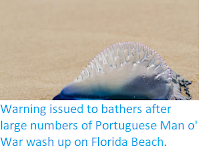Thousands of By-the-wind-sailors, Velella velella, small colonial Hydrozoans distantly related to the Portuguese Man o' War, Physalia physalis, washed up on the beaches of Palavas-les-Flots near Montpelier in the Hérault department, on France's Mediterranean coast on Tuesday 10 April 2018. While these brightly coloured and superficially Jellyfish-like animals are alarming, they are considerably less dangerous than the Portuguese Man o' War, as their toxin is not particularly harmful to Humans, though it is worth avoiding handling them, as they can cause itching and some people may have an allergy to the sting.
Thousands of By-the-wind-sailors, Velella velella, washed up on a beach at Palavas-les-Flotsin Southern France this week. Charente Libre.
Like the Portuguese Man o' War, By-the-wind-sailors are colonial Siphonophores only distantly related
to true Jellyfish, Scyphozoa, though commonly referred to as such. Their
bodies are made up of thousands of individual zooids, each with their
own sting, tentacles and digestive system. New zooids are formed by
budding from other members of the colony, but remain attached to these
to form a single colony. These animals are
anchored to the sea surface by a highly modified zooid which forms an
air sack, filled with a mixture of carbon monoxide defused from the
zooid and nitrogen, oxygen and argon from the atmosphere, which are
brought into the sack through osmosis.
However they are rather smaller, with colonies seldom exceeding 7 cm in length, and differ somewhat in their reproductive cycle, with alternative generations of sexual colonies, which may be male or female and reproduce sexually, budding off asexual stages medusae, which are about a mm across, and produce eggs which can go on to form new colonies.
See also...
Follow Sciency Thoughts on Facebook.






